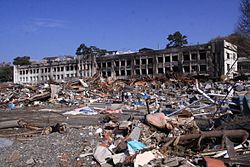Tsunami damage reduction effect because of the control forest and breakwaters in Ishinomaki city
(c) Anawat Suppasri, Nobuo Shuto, Fumihiko Imamura, Shunichi Koshimura, Erick Mas, Ahmet Cevdet Yalciner, CC BY 2.0
Autor/Urheber:
Anawat Suppasri, Nobuo Shuto, Fumihiko Imamura, Shunichi Koshimura, Erick Mas, Ahmet Cevdet Yalciner: "Lessons Learned from the 2011 Great East Japan Tsunami: Performance of Tsunami Countermeasures, Coastal Buildings, and Tsunami Evacuation in Japan", Pure and Applied Geophysics, 170, 6-8, (2013), pp. 993–1018, DOI:10.1007/s00024-012-0511-7, online published on 7 July 2012, here: p. 1004, Figure 15 ("Tsunami damage reduction effect because of the control forest and breakwaters in Ishinomaki city"), Licence: Creative Commons Attribution 2.0 Generic (CC BY 2.0).
Shortlink:
Quelle:
Größe:
1533 x 703 Pixel (314806 Bytes)
Beschreibung:
Source: Anawat Suppasri, Nobuo Shuto, Fumihiko Imamura, Shunichi Koshimura, Erick Mas, Ahmet Cevdet Yalciner: "Lessons Learned from the 2011 Great East Japan Tsunami: Performance of Tsunami Countermeasures, Coastal Buildings, and Tsunami Evacuation in Japan", Pure and Applied Geophysics, 170, 6-8, (2013), pp. 993–1018, DOI:10.1007/s00024-012-0511-7, online published on 7 July 2012, here: p. 1004, Figure 15 ("Tsunami damage reduction effect because of the control forest and breakwaters in Ishinomaki city"), Licence: Creative Commons Attribution 2.0 Generic (CC BY 2.0).
Caption as given in the above cited source: "Figure 15 - Tsunami damage reduction effect because of the control forest and breakwaters in Ishinomaki city"
Context as given in the above cited source: "Figure 15 shows a good example of how control forests and breakwaters could have helped to reduce the damage to areas behind them in Ishinomaki city. This figure was created by visual inspection of satellite images, with gray indicating the area of tsunami inundation by the 2011 tsunami, red indicating the areas where houses were washed away, and blue indicating the areas with surviving houses (TEL, 2011). It is very clear that the number of houses washed away in zone B (behind the control forest) is much smaller than that in zone A (without a control forest). Gokon and Koshimura (2012) showed that the probability of a building being washed away in zone C (inside the breakwaters) was ~40 %, whereas in zone D (outside the breakwaters), it was almost as high as 90 %, confirming the 50 % reduction effect, although both areas experienced a maximum tsunami height lower than 7 m."
Kommentar zur Lizenz:
Diese Datei ist unter der Creative-Commons-Lizenz „Namensnennung 2.0 generisch“ (US-amerikanisch) lizenziert.
Namensnennung: Anawat Suppasri, Nobuo Shuto, Fumihiko Imamura, Shunichi Koshimura, Erick Mas, Ahmet Cevdet Yalciner
- Dieses Werk darf von dir
- verbreitet werden – vervielfältigt, verbreitet und öffentlich zugänglich gemacht werden
- neu zusammengestellt werden – abgewandelt und bearbeitet werden
- Zu den folgenden Bedingungen:
- Namensnennung – Du musst angemessene Urheber- und Rechteangaben machen, einen Link zur Lizenz beifügen und angeben, ob Änderungen vorgenommen wurden. Diese Angaben dürfen in jeder angemessenen Art und Weise gemacht werden, allerdings nicht so, dass der Eindruck entsteht, der Lizenzgeber unterstütze gerade dich oder deine Nutzung besonders.
Lizenz:
Credit:
Anawat Suppasri, Nobuo Shuto, Fumihiko Imamura, Shunichi Koshimura, Erick Mas, Ahmet Cevdet Yalciner: "Lessons Learned from the 2011 Great East Japan Tsunami: Performance of Tsunami Countermeasures, Coastal Buildings, and Tsunami Evacuation in Japan", Pure and Applied Geophysics, 170, 6-8, (2013), pp. 993–1018, DOI:10.1007/s00024-012-0511-7, online published on 7 July 2012, here: p. 1004, Figure 15 ("Tsunami damage reduction effect because of the control forest and breakwaters in Ishinomaki city"), Licence: Creative Commons Attribution 2.0 Generic (CC BY 2.0).
Relevante Bilder





(c) Anawat Suppasri, Nobuo Shuto, Fumihiko Imamura, Shunichi Koshimura, Erick Mas, Ahmet Cevdet Yalciner, CC BY 2.0


(c) Anawat Suppasri, Nobuo Shuto, Fumihiko Imamura, Shunichi Koshimura, Erick Mas, Ahmet Cevdet Yalciner, CC BY 2.0


(c) Anawat Suppasri, Nobuo Shuto, Fumihiko Imamura, Shunichi Koshimura, Erick Mas, Ahmet Cevdet Yalciner, CC BY 2.0




















Relevante Artikel
IshinomakiIshinomaki ist eine Großstadt in der Präfektur Miyagi auf Honshū, der Hauptinsel von Japan. .. weiterlesen
